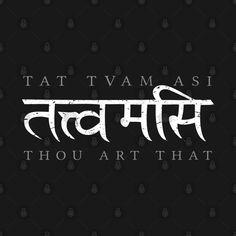Tat Twam Asi | तत् त्वम् असि | तत्त्वमसि
Tat Twam Asi is one of the four prominent mahavakyas. The four prominent mahavakyas are :
- प्रज्ञानं ब्रह्म Prajnanam Brahma (Consciousness is Brahman) in the Aitareya Upanishad of the Rig-Veda
- अहं ब्रह्मास्मि Aham Brahmasmi (I am Brahman) in the Brihadaranyaka Upanishad of the Yajur-Veda
- तत्त्वमसि Tat Tvam Asi (That thou art) in the Chandogya Upanishad of the Sama-Veda
- अयम् आत्मा ब्रह्म Ayam Atma Brahma (this Atman is Brahman) in the Mandukya Upanishad of the Atharva- Veda.
To grasp the true meaning of tat tvam asi, we should begin with the context of this statement in Chandogya Upanishad.
Context of Tat Twam Asi in “Chandogya Upanishad”
The Chandogya is one of the twelve major Upanishads. Here, the sage Uddalaka sends his son Svetaketu to Gurukula for learning the Vedas. Svetaketu accordingly spends twelve full years in learning the scriptures and thus returns home with the vanity of being learned.
His father asks him ” My dear, why are you so conceited? Have you learnt that, by learning which the unheard becomes heard, the unknown becomes known, the unperceived becomes perceived?”
“How is it?” asks Svetaketu
And the father gives the reply ” It is just as by knowing one clod of clay all that is made of clay is known: for whatever the modifications of the effects are, they are only names, and have their origin in speech. One who knows the cause knows all its effects, since the cause and its effects are non-different.
The effect is nothing but the cause. Hence the body is nothing but food, food is nothing but water, water is nothing but fire, fire is nothing but Sat. Sat alone is true, and That thou art!!”
Sage Uddalaka gives nine examples and repeats the Mahavakya Tat Tvam Asi, with each of them, to bring home to Svetaketu the real significance of the great sentence. Evidently That refers to Sat or God, the creator, and Thou refers to the individual soul. Art or Asi connects them both, indicating thus an identity between the two.
The original reading goes this way: सा अत्मातत्वमसि (Sa Atmatvam Asi). “Sa atmaa-tat tvam asi”.
What does Tatvamasi/ Tat Twam Asi mean?
The direct translation of this term stems from three Sanskrit roots:
- Tat meaning “that”.
- Tvam meaning “you”.
- Asi meaning “you were”
“That is you” or, “That art thou”
Tat Tvam Asi unites the macrocosmic ideas of God and universal consciousness with the microcosmic individual expression of the Self. To recite Tat Tvam Asi is to recognize that Brahman and Atman are one, and as such, there can be no ego or sense of separation. The transcription “I am that” is attributed to Adi Shankara, an 8th-century Indian philosopher who centered his Advaita Vedanta ( Know more https://en.wikipedia.org/wiki/Advaita_Vedanta ) doctrine around the phrase. Although there are many Interpretations on this given by various Vaishnav Acaryas, disproving the interpretation of Shankaracarya, including the one given by Madhvacarya, which is सा अत्मातत्वमसि (Sa atma-atat tvam asi) You are NOT that (Brahman).
It is simply a matter of identification. The most general meaning of the saying goes as that the Self – in its original, pure, primordial state – is identifiable with the Ultimate Reality that is the ground and origin of all phenomena.
Final Takeaway
Tat Twam Asi – That Thou Art, the inner Self, the untarnished pure Soul is nothing but the Brahman. You are verily That, but you must also realise that ! Bridging this gap is our supreme spiritual goal.
Read also : Understanding Yantra | Meaning, Types & Benefits ( https://thebrightdelights.com/understanding-yantra-meaning-types-benefits/ )
